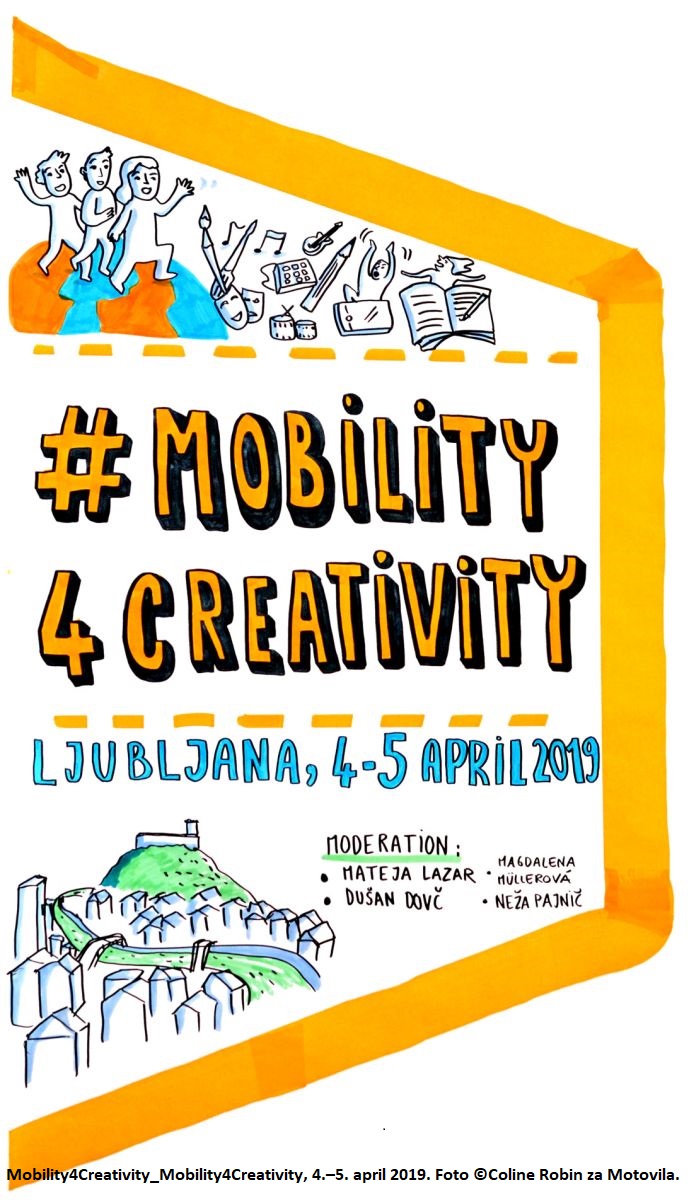Novice
What about a (SLOW) MOBILITY MANIFESTO?
Jana Renée Wilcoxen summarizes the conference titled “Mobility for Creativity” organised by Motovila in Ljubljana on 4–5 April 2019. Would you consider lowering your kWH/day consumption in the areas of transport? See how and let’s continue the discussion about mobility!
As (creative) humans, we don’t really like either/or situations. Dr. Bogataj’s talk on Thursday sent many of us into a tailspin of sorts when she said, “Mobility is great, but …” and then listed all the dangers and impacts of our travels on the environment, our health and the health of other inhabitants of the planet. We were crying to ourselves: “But we can’t just stay at home!”
On Friday, we heard more about the artistic issues that can arise with mobility – issues of copy/paste, generic programmes, the lack of understanding about the role of the artist participating in them and their needs while participating in residencies or exchange programmes from the experiences of an artist and a curator. We also heard about the social-political issues of who travels, why and to where, as well as for what purpose and varying opinions about how to measure the results. It’s clear that if we are forced into an either/or position, none of us feel very free in that decision or in our actions, as if we must give up mobility completely or feel guilty about our mobility activities or that we must once again subject the arts and artists to be the mediators of social change.
Indeed, this question of the role of the arts and artists today could be the topic of another conference, so for now we stayed only on the level of questions – questions that we add to our increased awareness of our environmental and social impact.
But these very questions are what can drive our decision-making in the future as we integrate this new information and test and (re)affirm our practices. So instead, we might consider changing that phrase to “Mobility is great, and … “and thus follow that and with the list of things that we would like to keep in mind.
If you start to be aware of how your ideas about mobility are shaped, you might take a moment to observe the spaces of airports and the advertising in them and maybe contrast them with the messaging and organisation of train stations. If we look at the messaging about flying and world travel, pay attention to the ads in the airports as well as in in-flight magazines. Compare and contrast them with those in your local train station. Could we consider a disruption in that type of messaging?
Dr. Lučka Kajfež Bogataj calls for innovation at all levels. Suggesting that airfare tickets cost more to offset the damage we do when we fly. That’s not to say we should never fly, but instead: How can we be more aware of what we are doing and the impact that our choices make on the society and environment as well as our own personal health and well-being?
Perhaps this innovation needs to take the form of a disruption.
In 1986, the Slow Food organisation started a worldwide movement about the importance of sustainability in our eating habits. Is it time to start a SLOW MOBILITY movement? Could we perhaps consider creating a mobility manifesto? What would such a document contain? Is this a task that we could take back to our organisations, artist associations, professional networks and working groups? Fatima Avila proposed that perhaps adding a point or two on environmentally-conscious mobility to the Canary Islands Declaration on Artistic and Cultural Mobility (2014).
We might consider how we could attempt to lower our kWH/day consumption in the areas of transport. A good place to look is the website Carbon Footprint which helps you to calculate your annual carbon footprint as well as offers ways of offsetting it. What if instead of frequent flyer miles, there was a frequent flyer tax? Or if one could use frequent flyer miles not to buy luxury items but to plant a tree, support ecological business development or other environmentally-friendly actions? What if people used their status to influence doing good for the planet and not having luxury for themselves? Nowadays low-fare airlines have taken the place of rail travel, especially for youth, who now hop around Europe by plane instead of hopping on and off of trains. Obviously these measures are beyond our sector, but we can start by raising awareness about the needs and issues in our local and global communities.
Participants at the conference took part in an intense 2-day experience of learning and networking which they will surely be able to take back to their colleagues and cities. Hopefully this report has given you further insight as well. This discussion will be continued at a conference organised by Arts and Theatre Institute (ATI) in cooperation with OTM, Culture of Mobility in the Time of Climate Change, in Prague on 25 April. You can even listen to it live stream.
In the words of Gareth Lee, “we leave feeling more connected and aware”. This connectivity comes with the knowledge that our actions affect a larger network of human and other living beings, systems and practices across many sectors and that through our connectivity we can have a stronger and more positive impact on the work that we do.
Perhaps there’s a new hashtag we could also use: #Creativity4Mobility.
Back to FULL REPORT by Jana Renée Wilcoxen for Motovila, Ljubljana 2019.
CC Attribution-NonCommercial 4.0 International (CC BY-NC 4.0).
Further information about the #Mobility4Creativity conference.
The event was organized by the Motovila Institute in cooperation with Arts and Theatre Institute / CED CZ, DutchCulture / CED NL, Centro de Informacão Europa Criativa / CED PT, CED Ireland – MEDIA Office Dublin, Ministry of Culture of the Republic of Croatia / CED HR, Federal Chancellery of Austria, Arts and Culture / CED AT, SCCA–Ljubljana and CMEPIUS.


